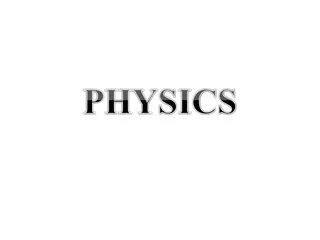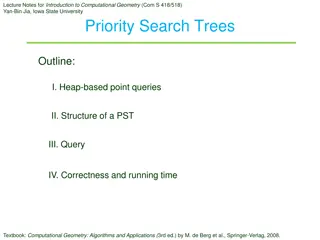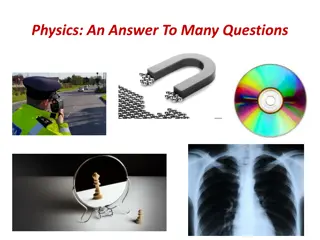Computational Physics (Lecture 18)
Neural networks explained with the example of feedforward vs. recurrent networks. Feedforward networks propagate data, while recurrent models allow loops for cascade effects. Recurrent networks are less influential but closer to the brain's function. Introduction to handwritten digit classification using neural networks. Describe challenges in breaking an image and classifying digits. Various approaches to segmentation problems are discussed.
Download Presentation

Please find below an Image/Link to download the presentation.
The content on the website is provided AS IS for your information and personal use only. It may not be sold, licensed, or shared on other websites without obtaining consent from the author.If you encounter any issues during the download, it is possible that the publisher has removed the file from their server.
You are allowed to download the files provided on this website for personal or commercial use, subject to the condition that they are used lawfully. All files are the property of their respective owners.
The content on the website is provided AS IS for your information and personal use only. It may not be sold, licensed, or shared on other websites without obtaining consent from the author.
E N D
Presentation Transcript
Computational Physics (Lecture 18) PHY4061
Neural networks where the output from one layer is used as input to the next layer. feedforward neural networks. This means there are no loops in the network information is always fed forward, never fed back. If we did have loops, we'd end up with situations where the input to the function depended on the output. That'd be hard to make sense of, and so we don't allow such loops. Current and future strongly couple with each other!
However, there are other models of artificial neural networks in which feedback loops are possible. These models are called recurrent neural networks. The idea in these models is to have neurons which fire for some limited duration of time, before becoming quiescent. That firing can stimulate other neurons, which may fire a little while later, also for a limited duration. That causes still more neurons to fire, and so over time we get a cascade of neurons firing. Loops don't cause problems in such a model, since a neuron's output only affects its input at some later time, not instantaneously.
Recurrent neural nets have been less influential than feedforward networks, in part because the learning algorithms for recurrent nets are (at least to date) less powerful. But recurrent networks are still extremely interesting. They're much closer in spirit to how our brains work than feedforward networks. And it's possible that recurrent networks can solve important problems which can only be solved with great difficulty by feedforward networks. In recent years, another new model called transformer emerged as an enhanced version of RNN in neutral language processing applications.
A simple network to classify handwritten digits Split the problem into two sub-problems. First, breaking an image containing many digits into a sequence of separate images, each containing a single digit. For example, break the image into
humans solve this segmentation problem with ease challenging for a computer program to correctly break up the image. Next, the program needs to classify each individual digit. So, for instance, to recognize that the first digit above, , is 5.
We'll focus on classifying individual digits. because segmentation problem is not so difficult Many approaches to solving the segmentation problem. One approach: to trial many different ways of segmenting the image Using the individual digit classifier to score each trial segmentation.
A trial segmentation gets a high score if the individual digit classifier is confident of its classification in all segments, a low score if the classifier is having a lot of trouble in one or more segments. The idea is that if the classifier is having trouble somewhere, then it's probably having trouble because the segmentation has been chosen incorrectly. This idea and other variations can be used to solve the segmentation problem quite well. So instead of worrying about segmentation we'll concentrate on developing a neural network which can solve the more interesting and difficult problem, namely, recognizing individual handwritten digits.
To recognize individual digits a three-layer neural network:
The input layer: neurons encoding the values of the input pixels. training data: 28 by 28 pixel images of scanned handwritten digits input layer contains 784=28 28 neurons. The input pixels are greyscale, with a value of 0.0 representing white, a value of 1.0 representing black, and in between values representing gradually darkening shades of grey.
The second layer: a hidden layer. denote the number of neurons in this hidden layer by n, We'll experiment with different values for n.
The output layer 10 neurons. If the first neuron fires, i.e., has an output 1, then that will indicate that the network thinks the digit is a 0 .. A little more precisely, we number the output neurons from 0 through 9, and figure out which neuron has the highest activation value. If that neuron is, say, neuron number 6, then our network will guess that the input digit was a 6. And so on for the other output neurons.
Why we use 10 output neurons? A seemingly natural way: 4 output neurons, treating each neuron as taking on a binary value. depending on whether the neuron's output is closer to 0 or to 1. Four neurons are enough to encode the answer, since 24=16 The ultimate justification is empirical: we can try out both network designs, For this particular problem, the network with 10 output neurons learns to recognize digits better than the network with 4 output neurons. Why? Is there some heuristic that would tell us in advance that we should use the 10-output encoding instead of the 4-output encoding?
From first principles: Consider first the case where we use 10 output neurons. Let's concentrate on the first output neuron, the one that's trying to decide whether or not the digit is a 0. It does this by weighing up evidence from the hidden layer of neurons. What are those hidden neurons doing?
Suppose the first neuron in the hidden layer detects whether or not an image like the following is present:
It can do this by heavily weighting input pixels which overlap with the image, lightly weighting the other inputs. Suppose the second, third, and fourth neurons in the hidden layer detect whether or not the following images are present:
four images together make up the 0 image that we saw in the line of digits shown earlier:
So if all four of these hidden neurons are firing the digit is a 0. Not the only sort of evidence we can use to conclude that the image was a 0 - we could legitimately get a 0 in many other ways (say, through translations of the above images, or slight distortions). But it seems safe to say that at least in this case we'd conclude that the input was a 0.
Supposing the neural network functions in this way, we can give a plausible explanation for why it's better to have 10 outputs from the network, rather than 4. If we had 4 outputs, then the first output neuron would be trying to decide what the most significant bit of the digit was. And there's no easy way to relate that most significant bit to simple shapes like those shown above. It's hard to imagine that there's any good historical reason the component shapes of the digit will be closely related to (say) the most significant bit in the output.
Learning with gradient descent We'll use the MNIST data set, tens of thousands of scanned images of handwritten digits, together with their correct classifications. MNIST's : modified subset of two data sets collected by NIST, the United States' National Institute of Standards and Technology.
The MNIST data comes in two parts. The first part: contains 60,000 images to be used as training data. scanned handwriting samples from 250 people half of whom were US Census Bureau employees, and half of whom were high school students. The images are greyscale and 28 by 28 pixels in size.
The second part of the MNIST data set is 10,000 images to be used as test data. We'll use the test data to evaluate how well our neural network has learned to recognize digits. The test data was taken from a different set of 250 people than the original training data This helps give us confidence that our system can recognize digits from people whose writing it didn't see during training.
The notation x to denote a training input. Convenient to regard each training input x as a 28 28=784 dimensional vector. Each entry in the vector represents the grey value for a single pixel in the image.
We'll denote the corresponding desired output by y=y(x), y is a 10-dimensional vector. For example, if a particular training image, x, depicts a 6, then y(x)=(0,0,0,0,0,0,1,0,0,0)Tis the desired output from the network.
What we'd like is an algorithm lets us find weights and biases so that the output from the network approximates y(x) for all training inputs x. To quantify how well we're achieving this goal we define a cost function C(w,b) 1/2n x y(x) a 2.
w denotes the collection of all weights in the network, b all the biases, n is the total number of training inputs, a is the vector of outputs from the network when x is input, The sum is over all training inputs, x.
The notation v just denotes the usual length function for a vector v. C is the quadratic cost function; it's also sometimes known as the mean squared error or just MSE. Inspecting the form of the quadratic cost function, we see that C(w,b) is non-negative, since every term in the sum is non-negative.
C(w,b) becomes small, i.e., C(w,b)0, when y(x) is approximately equal to the output, a, for all training inputs, x. So our training algorithm has done a good job if it can find weights and biases so that C(w,b) 0. By contrast, it's not doing so well when C(w,b) is large - that would mean that y(x) is not close to the output a for a large number of inputs. So the aim of our training algorithm will be to minimize the cost C(w,b) as a function of the weights and biases. gradient descent.
Why introduce the quadratic cost? After all, aren't we primarily interested in the number of images correctly classified by the network? Why not try to maximize that number directly, rather than minimizing a proxy measure like the quadratic cost? The problem with that is that the number of images correctly classified is not a smooth function of the weights and biases in the network.
Making small changes to the weights and biases won't cause any change at all in the number of training images classified correctly. Difficult to figure out how to change the weights and biases to get improved performance. If we instead use a smooth cost function like the quadratic cost it turns out to be easy to figure out how to make small changes in the weights and biases so as to get an improvement in the cost.
Why we choose the quadratic function used in Equation. the quadratic cost function works perfectly well for understanding the basics of learning in neural networks.
Let's think about what happens when we move a ball a small amount v1 in the v1 direction, and a small amount v2 in the v2 direction. Calculus tells us that C changes as follows: C ( C/ v1) v1+( C/ v2) v2. Choose v1 and v2 so as to make C negative; i.e., we'll choose them so the ball is rolling down into the valley. We'll also define the gradient of C to be the vector of partial derivatives, gradient vector: C ( C/ v1, C/ v2)T.
With these definitions, C can be rewritten as C C v. C relates changes in v to changes in C, In particular, suppose we choose v= C, where is a small, positive parameter (known as the learning rate).
Writing out the gradient descent update rule in terms of components, we have wk w k=wk C/ wk bl b l=bl C/ bl.
to compute the gradient C, we need to compute the gradients Cxseparately for each training input, x, and then average them, C=1/n x Cx. Unfortunately, when the number of training inputs is very large this can take a long time, and learning thus occurs slowly.
An idea called stochastic gradient descent can be used to speed up learning. The idea is to estimate the gradient C by computing Cxfor a small sample of randomly chosen training inputs. By averaging over this small sample it turns out that we can quickly get a good estimate of the true gradient C, and this helps speed up gradient descent, and thus learning.
We can think of stochastic gradient descent as being like political polling: it's much easier to sample a small mini-batch than it is to apply gradient descent to the full batch, just as carrying out a poll is easier than running a full election. For example, if we have a training set of size n=60,000, as in MNIST, and choose a mini-batch size of (say) m=10, this means we'll get a factor of 6,000 speedup in estimating the gradient! Of course, the estimate won't be perfect - there will be statistical fluctuations - but it doesn't need to be perfect: all we really care about is moving in a general direction that will help decrease C, and that means we don't need an exact computation of the gradient. In practice, stochastic gradient descent is a commonly used and powerful technique for learning in neural networks.
Implementing our network to classify digits Please read the book to learn how to down load the MNIST data and PYTHON library.
The core features of the neural networks code: The centerpiece is a Network class, which we use to represent a neural network. Here's the code we use to initialize a Network object:
the list sizes contains the number of neurons in the respective layers. For example, if we want to create a Network object with 2 neurons in the first layer, 3 neurons in the second layer, and 1 neuron in the final layer, we'd do this with the code: net = Network([2, 3, 1])
The biases and weights in the Network object are all initialized randomly, using the Numpy np.random.randn function to generate Gaussian distributions with mean 0 and standard deviation 1. This random initialization gives our stochastic gradient descent algorithm a place to start from. Note that the Network initialization code assumes that the first layer of neurons is an input layer, and omits to set any biases for those neurons, since biases are only ever used in computing the outputs from later layers.
Defining the sigmoid function: def sigmoid(z): return 1.0/(1.0+np.exp(-z)) Add a feedforward method to the Network class, which, given an input a for the network, returns the corresponding output def feedforward(self, a): """Return the output of the network if "a" is input.""" for b, w in zip(self.biases, self.weights): a = sigmoid(np.dot(w, a)+b) return a
The stochastic gradient desent: Please refer to the text book to read the code and details.
It's not difficult to find ideas which achieve accuracies in the 20 to 50 percent range. If you work a bit harder you can get up over 50 percent. But to get much higher accuracies it helps to use established machine learning algorithms. Let's try using one of the best known algorithms, the support vector machine or SVM. If we run scikit-learn's SVM classifier using the default settings, then it gets 9,435 of 10,000 test images correct. The current (2013) record is classifying 9,979 of 10,000 images correctly. This was done by Li Wan, Matthew Zeiler, Sixin Zhang, Yann LeCun, and Rob Fergus.
Toward deep learning Can we find some way to understand the principles by which our network is classifying handwritten digits? And, given such principles, can we do better?
Suppose that a few decades hence neural networks lead to artificial intelligence (AI). Will we understand how such intelligent networks work? Perhaps the networks will be opaque to us, with weights and biases we don't understand, because they've been learned automatically. In the early days of AI research people hoped that the effort to build an AI would also help us understand the principles behind intelligence and, maybe, the functioning of the human brain. But perhaps the outcome will be that we end up understanding neither the brain nor how artificial intelligence works!
Suppose we want to determine whether an image shows a human face or not We could attack this problem the same way we attacked handwriting recognition with the output from the network a single neuron indicating either "Yes, it's a face" or "No, it's not a face".
Suppose we're not using a learning algorithm. To design a network by hand, choosing appropriate weights and biases. How might we go about it? a heuristic we could use is to decompose the problem into sub-problems: does the image have an eye in the top left? Does it have an eye in the top right? Does it have a nose in the middle? Does it have a mouth in the bottom middle? Is there hair on top? And so on.
Still, the heuristic suggests that if we can solve the sub-problems using neural networks, then perhaps we can build a neural network for face- detection, by combining the networks for the sub-problems. Here's a possible architecture, with rectangles denoting the sub-networks. Note that this isn't intended as a realistic approach to solving the face-detection problem; rather, it's to help us build intuition about how networks function.























